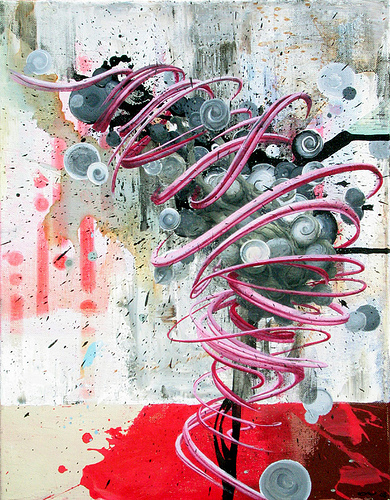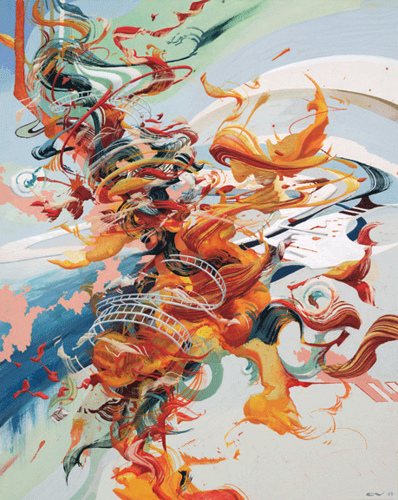
Jason: Tell us a little about who Oliver Vernon is? Where do you live and tell us what would it be like to have a glimpse into your lifestyle / background?
Oliver: After graduating from Parsons in 95, I lived in Brooklyn for almost 15 years before breaking the spell and moving over to the West Coast, where I’m now set up in Oakland.
Jason: I see that you studied at the University of Vermont, Burlington, while also obtaining your BFA at Parsons School of Design, New York. Before this what was your artistic background ? Where you artistic as a child?
Oliver: My parents were both artists (father a painter/sculptor/musician, mother a modern dancer) who filled our home with art. Through my childhood years I was encouraged to exercise my creativity in many forms. My bedroom walls were covered with bmx and skateboarding pictures, together with hand-drawn copies of all my favorite logos. I remember really being into making these meteor/space-ship drawings. I would make a random meteor outline, and then inside I would subdivide the space into all these interconnected rooms and chambers. I would add dining halls, sleeping quarters, aircraft building dept., caged monsters, even a dance floor covered in little figures with their hands in the air under a shining mirror ball (not to mention the oodles and oodles of missile silos.) Building skateboard ramps and obstacles was good training in bringing ideas to life through design, and got me started into basic architectural thinking.
Jason: As child growing up what was a normal day in the life of Oliver Vernon?
Oliver: I was often in the woods, climbing trees, building forts, building bmx jumps, sledding, catching tadpoles. We had a big clan of kids in my suburban hood how would always gather for epic football matches, ice hockey on friend’s homemade backyard rink, big-wheel smash-up derby, kick-the-can. I was having break dancing battles in school and in my basement which was covered in cardboard. I played in youth-hockey and soccer leagues, went skiing as much as possible, camped in the Adirondack Mountains with family.

Jason: With that said, I was compelled to ask the above question because there is such a variety in human experience and a seemingly limitless individual imagination, that art includes such a wide range of expression. The human mind may find artistic expression in almost every endeavor. What is it that leads you to create the work that you do? Is it a form of self expression or simply aesthetics?
Oliver: Everything comes into play. Certainly I am very concerned with aesthetics, as I am a lover of beauty. Through my work my aim is to be a conduit for life’s expression to come through me.
Jason: After graduating there was a slight gap between your schooling and the first time we saw your works in a gallery, in between this time what was taking place artistically?
Oliver: I was working in a painting restoration studio, where I learned what it was like to work at an easel, how to handle tiny brushes, and how to match colors using traditional color wheel theory. I was also diving deep into underground dance music/DJ culture, which had a very impacting force on my creative mind. I was painting but my studio was overrun by turntables and records, as the art of djing became a very satisfying form of self expression. I started doing murals in clubs, bars, restaurants, yoga studios, private venues, and began doing live painting performances at the famous Giant Step parties (they were the first organizers I saw booking painters for their events.) I befriended the artist Alex Grey who offered me great support and mentorship.
Jason: Without too much overstatement, you are best known for your unique style of chaos and order, can you tell us a little about how this method of painting was brought to life?
Oliver: Portrayals of chaos and order in painting are nothing new. Mark Tobey is one of the early examples from the early 20th, whose dense all-over abstractions sought to explore the representation of the spiritual in art. Jackson Pollack is the most famous example. At the core I identify with these artists in their vision, however I feel the need to implement a multitude of varied techniques, methods, approaches, and to fuse them together into unified wholes. The world, and life itself, seems often like chaos… a staggering myriad of opposing forces moving in visible and invisible cycles, all co-existing in a simultaneous, interdependent system. What meditation has given me was the ability to sit quietly with this great chaos and to feel the perfection in its balance. It’s like witnessing from the eye of the hurricane…there is serenity within the madness of it all.

Jason: What are your biggest inspirations? And what is it that influences you most when going through the creative process of painting a piece?
Oliver: I cannot list inspirations in order. Life, love, the struggle, the adventure…these are the big ones. Sure there are countless people, places and experiences which have inspired me and continue to do so all the time. But it is the quality of the inspiration itself rather than the source of the inspiration which affects my work. The inspiration remains after the source has left…and if this feeling of inspiration could be visualized, this is a subject I’m interested in.
Jason: Which living (or dead) artists do you find inspiring? Do you feel connected to the abstract expressionism / post –pop surrealism scene? Or do you personally see your work in a different light?
Oliver: I followed in the steps of the AbEx masters and the early surrealists, for whom Automatism was the agenda: spontaneous stream-of-consciousness automatic composition. Feeling was more important than description. I liked the early surrealists Miro, Matta, & Ernst… from the mid 20th I like Motherwell, Kline, Rothko, Pollack, Frankenthaler, Mitchell, DeKooning. Cubism was a powerful force on my creative mind as well as other “modern” developments from Braque, Leger, Mondrian, Kandinsky, Delaunay, Davis.
Jason: As an artist of many mediums can you explain to us your technique? Your painting is so refined’ the tiniest of objects are rendered so perfectly. How do you start a painting?
Oliver: Generally the process begins loose, allowing me to explore gestural mark making in a way that is not connected to finished result, as elements are painted over again and again. As the composition develops intuitively, form suggests itself to me and I follow. Painting is like chess, each move is informed by the previous, and opens a new range of possibilities. I stay open throughout the process so that the “story” of the painting can be revealed to me.

Jason: When and where do you decide to end? Is there a method to your madness?
Oliver: My first painting mentor Frank Hewitt once told me, “it takes two people to make a painting…one to do the painting and the other to hit him over the head with a hammer when it is finished.”
Jason: Your work is so highly imaginative and evolved thematically. Is the mythology in your work something that was with you as a child? And how has this technique developed over the years?
Oliver: I give George Lucas credit for implanting mythology into my childhood mind through Star Wars, which later led me into a deep personal study of the eastern wisdom tradition.
Jason: Do you see your work drastically changing in the future, and is it important to your progression as an artist to constantly evolve?
Oliver: If the work is not evolving then it is dead. I’m interested in what breakthroughs lie ahead…this is what motivates me.
Jason: What do you find to be the greatest challenges of being an artist?
Oliver: There is an atmosphere of seclusion that naturally comes with a being a studio artist. My intense desire for progress keeps me focused, but over the years I’ve found myself losing a bit of the well-roundedness that was with me before painting devoured all my time. I find it a great challenge to pull myself away from the work, to take time off, to give my creative mind some resting space.

Jason: If you were not an artist what would be your chosen profession or better yet what could you picture yourself doing if art was not an option for you?
Oliver: As I was applying to art schools, Architecture was competing with painting as a path worthy of taking. If art wasn’t an option, or architecture, then I would be a massage therapist.
Jason: When you are not painting what do you enjoy doing?
Oliver: Making love, playing at the beach, yoga, and epic back-country adventures.
Jason: What do you want people to walk away with after looking at your paintings? Does it matter to you? And do you think of the audience when you are producing a piece?
Oliver: If one has something in their mind opened from looking at one of my paintings, I’m happy. If their mind is blown, even better. I want people to experience a new kind of seeing.. I want to shake up their normal modes of perception. I do think of the audience sometimes, but the best moves are made when the audience is not in mind.

Jason: For those unfamiliar with your work how would you best describe it?
Oliver: I try to avoid descriptions as much as possible, because descriptions detract from the mystery, which is a key strength to what painting has to offer. There is certainly a fusion happening, a symphonic blend of many different types of painting languages and techniques. There is an ongoing examination of space, of how different planes and dimensions of space coexist and interrelate.
Jason: And if you had to describe your work in three words or less…?
Oliver: Bold, Provocative, Complex
Jason: With your series of paintings such as “Blue Swirl” or “Subway Translation”, how do you go about naming a particular piece, are the paintings based around a concept or the concept based on the paintings? Which originates first?
Oliver: I keep lists of possible titles, and then when the works are near finished I will find the right match. I like titles which are a little ambiguous and have a range of possible readings. Sometimes the titles are merely reference titles, as in Blue Swirl and Subway Translation, where there is no intention of using the title to be be a springboard for thoughts or contemplations about the work. Other times a title can be a trigger to open a new angle of perceiving the image.

Jason: What is your philosophy as an artist?
Oliver: To express purely with honesty.
Jason: What type of atmosphere do you like to paint in, is there a specific setting, time of day, music etc.. That is essential to your creative process? And what is it that motivates you to stay focused while working in a piece?
Oliver: I spend time making the studio as beautiful as possible. The atmosphere in a room affects the state-of-mind which affects the work. Typically my sessions take place morning, noon, and night. Each time of day, or each type of music, has a different vibe and offers a unique psychological space which directly affects the work that comes out.
